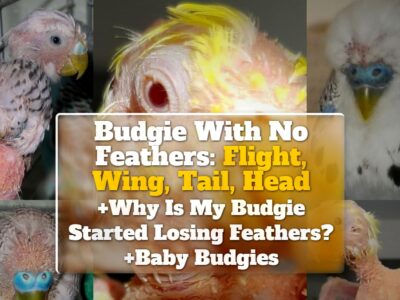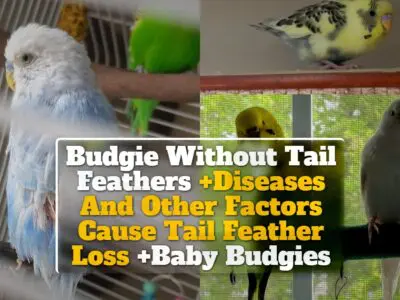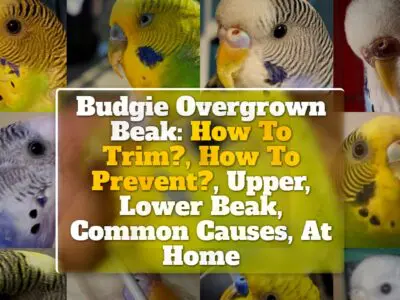Budgies lose feathers for various reasons.
This could be natural, like molting – a process where old feathers are shed to make way for new ones.
Alternatively, diseases, parasitic infections, stress, or dietary issues can also cause feather loss.
Specific body parts, like the beak, neck, head, chest, flight wings, and tail, may show this loss.
This guide is intended for anyone interested in understanding why budgies lose their feathers.
My experience as a budgie owner, coupled with extensive reading and research, has equipped me with the knowledge to address this concern.
I hope my insights can help others who may be facing similar situations with their feathered friends.
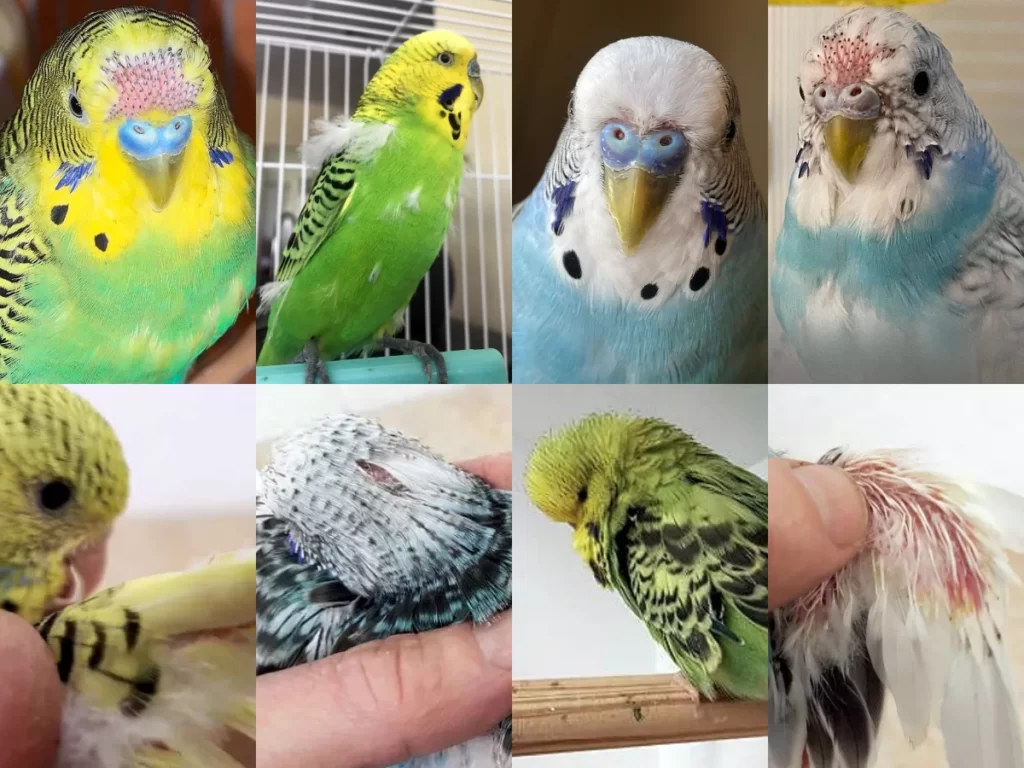
What Are The Common Causes Of Budgies Losing Feathers?
The loss of feathers in budgies, also known as parakeets, can occur due to a variety of reasons.
This is often a natural occurrence, but sometimes it may indicate an underlying health problem.
Now, here we discuss some common causes which include molting, poor diet, parasitic infections, and stress.
Molting
Molting is a natural process where birds, including budgies, shed their old feathers and grow new ones.
It’s a normal part of their life cycle and essential for maintaining a healthy plumage.
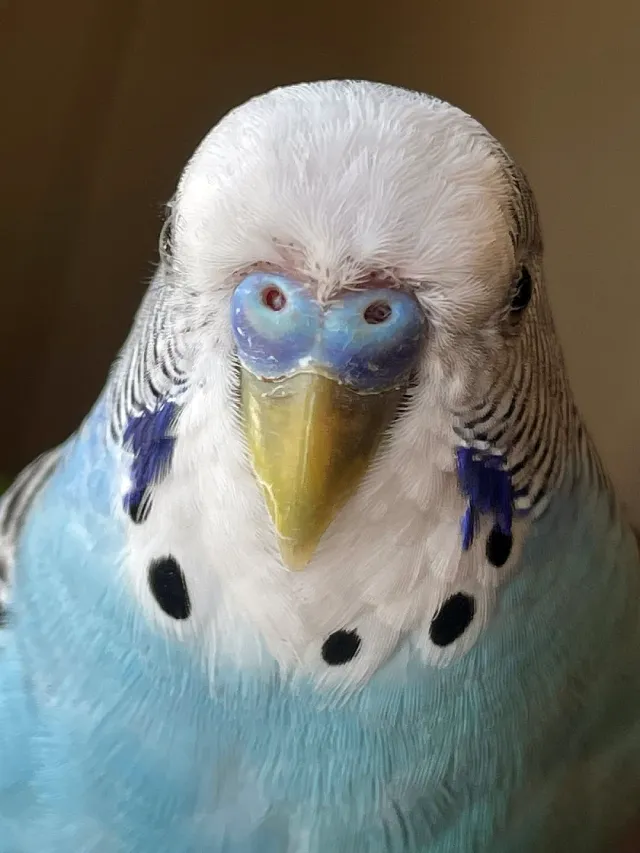
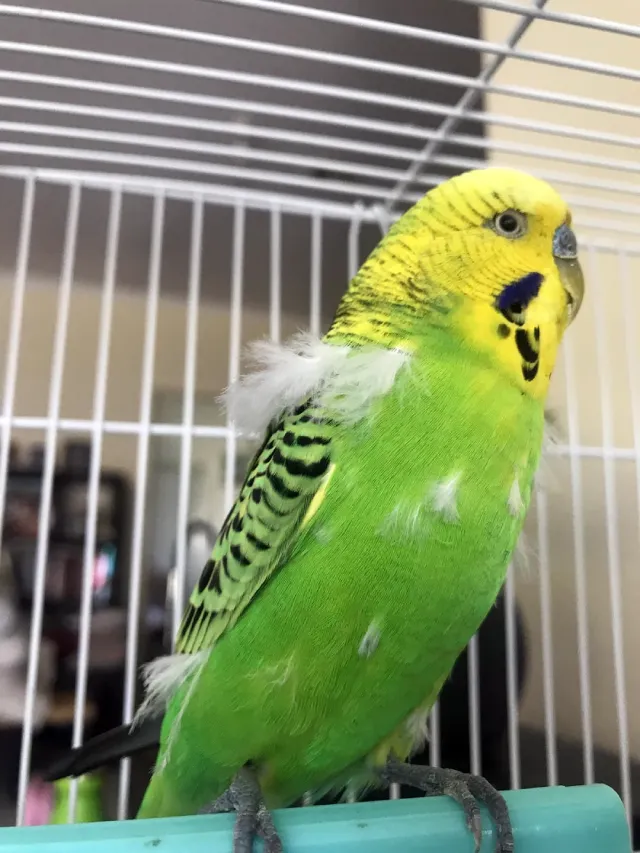
Seasonal Molting
Seasonal molting often occurs as a response to changing seasons.
It’s a common phenomenon in many bird species, including budgies.
It usually happens once or twice a year, primarily during the spring and fall.
Budgies may lose feathers symmetrically, with the new feathers, known as pin feathers, quickly growing back to replace the old ones.
Juvenile Molting
In contrast to seasonal molting, juvenile molting happens as budgies transition from their juvenile to adult stage.
This type of molting is a crucial part of their growth and development.
During this period, they lose their baby feathers, and their new, adult feathers emerge.
Juvenile molting often occurs when the bird is around 3 to 4 months old.
Poor Diet
A poor diet can also lead to feather loss in budgies.
An inappropriate or insufficient diet can cause various nutritional deficiencies that may manifest in the form of feather abnormalities.
Vitamin Deficiency
A deficiency in certain vitamins, notably vitamins A, B, D, E, and K, can result in poor feather quality, discoloration, and even feather loss.
Vitamin A, in particular, plays a vital role in maintaining the health of a bird’s skin and feathers.
A lack of it can cause dry, flaky skin and dull feathers.
Mineral Deficiency
Mineral deficiencies, particularly calcium and zinc, can also cause budgies to lose their feathers.
Calcium is essential for feather strength, while zinc plays a role in feather growth.
A lack of these minerals can lead to brittle feathers that fall out easily.
Protein Deficiency
A protein deficiency can lead to feather loss in budgies.
Feathers are primarily made of a protein called keratin.
If a budgie’s diet lacks sufficient protein, it can result in thin, fragile feathers that break easily, leading to feather loss.
Feather Picking
Feather picking, or over-preening, is a condition in which a budgie excessively preens or plucks its own feathers, leading to their loss.
It is often symptomatic of underlying issues ranging from behavioral problems to medical conditions.
Behavioral Causes
One of the primary reasons for feather picking can be behavioral disorders.
These can include stress, boredom, or anxiety.
Changes in the environment, such as a new cage, different feeding times, or the introduction of new pets or family members, can lead to stress and result in feather picking.
Social Isolation
Budgies are social creatures and need interaction with their peers or their human caregivers.
Social isolation can lead to psychological distress in budgies, manifesting as feather picking.
Regular interaction and social stimulation can help mitigate this issue.
Bullying – Inter-Budgie Aggression
In multi-bird environments, bullying can occur, which can cause the bullied bird to pick its feathers out of stress.
In some situations, one budgie dominates or bullies another, which can include behaviors like feather picking.
In such scenarios, the dominant bird may pluck the feathers of the other, leading to noticeable feather loss.
Monitoring the interactions among the birds and separating aggressive birds can help prevent this problem.
External Parasites
External parasites, such as mites and lice, can also cause budgies to lose feathers.
These parasites irritate the bird, leading to excessive preening or scratching, which can result in feather loss.
Mites
Mites, particularly the Scaly Face mite and the Feather mite, are microscopic parasites that burrow into a budgie’s skin, causing intense itching and discomfort, leading to feather loss.
Mites can also cause damage to the feather follicles, hindering the growth of new feathers.
Lice
Lice are another type of external parasite that can infest budgies.
These pests chew on the bird’s feathers, causing them to become damaged and fall out.
The budgie may also preen excessively due to the discomfort caused by the lice, leading to feather loss.
Feather Mites
Feather mites are another common parasite that affects budgies.
These mites live on and consume the keratin in bird feathers.
Infected birds will often over-preen or pluck out their feathers in an attempt to alleviate the discomfort caused by the mites.
Skin Infections Or Diseases
Skin infections or diseases can be a significant cause of feather loss in budgies.
These can be caused by fungi, bacteria, viruses, allergic reactions, or autoimmune disorders.
Fungal Infections
Fungal infections, such as those caused by Candida or Aspergillus species, can lead to feather loss in budgies.
The fungi cause irritation and inflammation on the skin, which can lead to over-preening or feather picking.
Bacterial Infections
Bacterial infections, including avian chlamydiosis and bacterial folliculitis, can cause feather loss.
These infections often cause redness, swelling, and discomfort, leading the bird to pick or scratch at the affected area.
Viral Infections
Some viral infections, like the psittacine beak and feather disease (PBFD), directly affect the feather follicles, leading to abnormal feather growth and subsequent loss.
PBFD is a serious condition that requires immediate veterinary intervention.
Allergic Reactions
Budgies can also lose feathers due to allergic reactions.
Allergens might be found in their food, bedding, or other environmental factors.
An allergic reaction often causes itching and irritation, leading to over-preening or feather picking.
Autoimmune Disorders
In rare cases, budgies can suffer from autoimmune disorders where the bird’s immune system attacks its own body tissues, including feathers.
Such conditions may cause inflammation and discomfort, leading to excessive preening and eventual feather loss.
French Moult
One disease of particular note in budgies that causes feather loss is French Moult.
This condition, often caused by the Beak and Feather Disease Virus (BFDV), leads to severe feather abnormalities and loss, especially in young budgies.
Affected birds may have underdeveloped, twisted, or absent flight feathers.
These symptoms often result in the inability to fly.
The severity of the disease varies, with some birds having mild feather abnormalities to others having severe loss of feathers and beak deformities.
It’s crucial for owners to seek immediate veterinary care if they suspect their budgie has French Moult, as early diagnosis and treatment can help manage the condition and improve the bird’s quality of life.
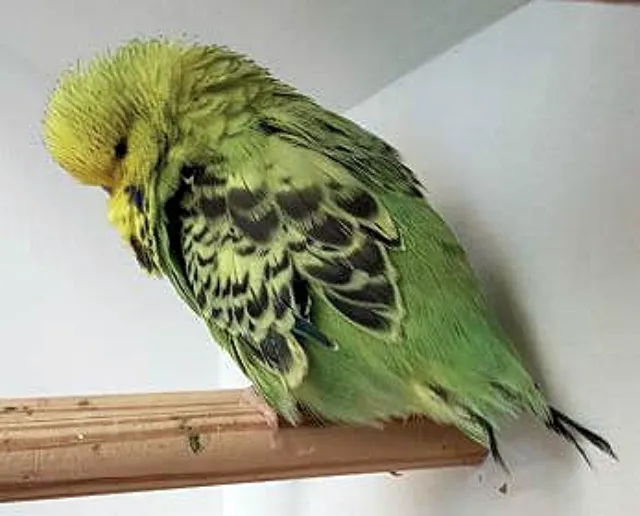
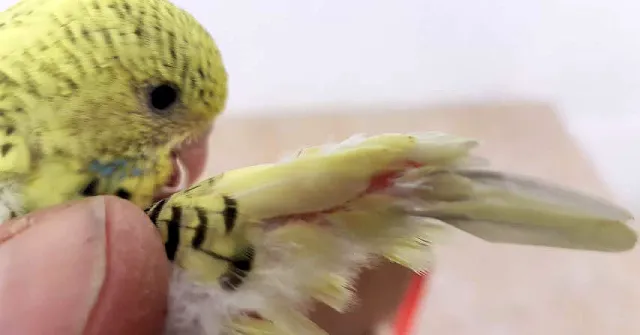
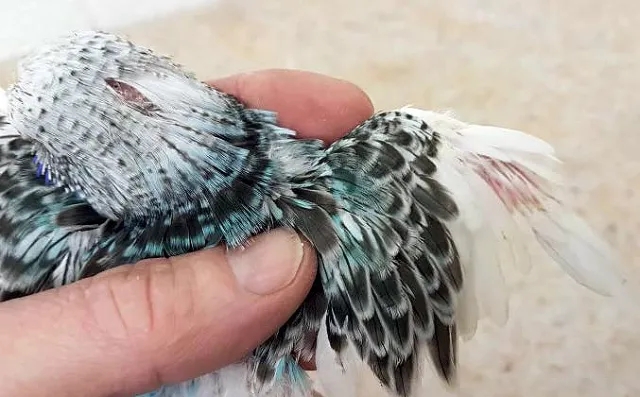
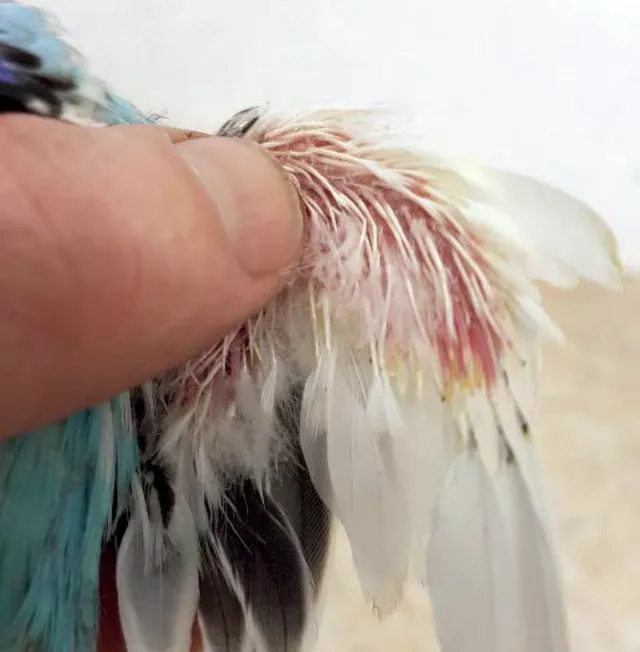
Environmental Factors
The environment where your budgie lives can significantly impact its health, including its feathers’ condition.
Factors such as temperature extremes, drafts, dry air, and exposure to toxins or chemicals can lead to feather loss.
Temperature Extremes
Budgies, originally from the moderate climates of Australia, can struggle with extreme temperatures.
Both excessive heat and cold can stress a budgie, leading to feather loss.
Keeping your budgie’s environment within a comfortable temperature range is vital for its overall health and feather condition.
Drafts
Drafts can cause sudden changes in temperature and potentially stress your bird.
Constant exposure to drafts can cause health problems, including respiratory infections, which can indirectly lead to feather loss.
Thus, placing the bird’s cage in a draft-free area is essential for maintaining good feather health.
Dry Air
Dry air can lead to dry, brittle feathers that are more prone to breakage.
Moreover, low humidity can cause skin dryness, leading to itching, discomfort, and possibly feather picking.
Using a humidifier or regular misting can help maintain optimal humidity levels.
Toxins Or Chemicals
Budgies are extremely sensitive to toxins and chemicals in their environment.
Exposure to harmful substances, including cigarette smoke, certain cleaning agents, or even some types of non-stick cookware, can cause respiratory issues and feather damage.
Therefore, it is crucial to ensure the budgie’s environment is free from such harmful substances.
What Are The Common Causes Of Regional Feather Loss In Budgies?
Feather loss in budgies can occur in specific areas of the body due to various reasons.
It’s crucial to pay attention to the location of feather loss as it can provide insights into the potential underlying cause.
Beak Feathers
Feather loss around the beak can be a sign of a beak disorder.
It may be due to trauma, infection, or an overgrown beak rubbing against the feathers, leading to loss.
This condition may also indicate mite infestation, specifically a type called scaly face mites.
Neck Feathers
Neck feather loss is often a sign of feather plucking, where the bird can reach easily.
It can also be due to the bird scratching at a skin irritation, possibly from a parasite infestation or skin condition.
Head Feathers
Budgies cannot reach their head feathers to pluck, so if they’re falling out, it’s likely due to another bird’s over-preening or bullying, an external parasite infestation, or a systemic health issue.
In some cases, molting can also lead to temporary head feather loss.

Chest Feathers
Feather loss on the chest is commonly associated with feather plucking due to stress, boredom, or skin irritation.
Chest feathers are easily accessible to budgies, making them a prime target for plucking.
This region’s feather loss can also signify nutritional deficiencies or hormonal imbalances.
Wings Feathers
Feather loss on the wings can occur due to self-inflicted trauma (feather plucking), external parasites, or fungal, bacterial, or viral infections.
Flight Feathers
Specifically, the loss of flight feathers can be due to heavy molting, malnutrition, or a stressful environment causing excessive plucking or barbering (trimming the feathers).
Loss of flight feathers can severely affect a budgie’s ability to fly, leading to poor quality of life.

Tail Feathers
Feather loss in the tail can occur due to rough handling, where the feathers can easily get damaged or pulled out.
It could also be due to self-plucking, especially if the budgie is stressed or anxious.
Parasite infestation or infections can also lead to tail feather loss.
What Are The Symptoms Of Budgies Losing Their Feathers? Leading To Feather Loss
Feather loss in budgies can be accompanied by a range of symptoms that can help identify the cause of the issue.
Observing these signs and symptoms can facilitate early intervention and treatment.
What Are The Physical Signs Of Budgies Losing Their Feathers?
Broken Or Damaged Feathers
Broken or damaged feathers are a telltale sign of feather loss in budgies.
The bird may have uneven, frayed, or split feathers.
You may also notice the bird frequently dropping feathers, which is beyond the normal scope of moulting.
Skin Irritation Or Redness
A budgie experiencing feather loss may also show signs of skin irritation or redness.
The skin around the feather loss area might appear inflamed, scaly, or have small red spots, indicating a potential parasite infestation, skin infection, or allergy.
Abnormal Preening Behavior
Budgies normally preen to keep their feathers in good condition.
However, excessive preening, to the point of damaging or plucking out their own feathers, can be a symptom of feather loss.
This behavior often indicates stress, boredom, or skin irritation.
Changes In Feather Coloration
Sometimes, the feather coloration can change, appearing dull or discolored.
Changes in feather coloration can be due to nutritional deficiencies, diseases, or stress.
It can also be a sign of the bird aging, especially if the color change is gradual and uniform.
Feather Fragments Or Downy Feathers
Feather fragments or the presence of excessive downy feathers can be a symptom of feather loss.
Budgies that are constantly plucking or losing their feathers will often have a lot of feather debris in their cage.
Signs Of Stress Or Discomfort
Feather loss in budgies can also be accompanied by signs of stress or discomfort, such as restlessness, decreased appetite, changes in droppings, and changes in vocalization or behavior.
Visible Signs Of Parasites
Visible signs of parasites, such as mites or lice, can be another symptom.
These could include moving spots on the bird’s skin, changes in the feather’s appearance, or visible parasites in the cage or on the bird itself.
What Are The Behavioral Signs Of Budgies Losing Their Feathers?
In addition to the physical symptoms, there are certain behavioral changes you may observe in budgies experiencing feather loss.
These can help provide insight into the severity of the problem and aid in diagnosis.
Increased Preening
Preening is a normal grooming behavior in budgies, where they use their beaks to align and clean their feathers.
However, increased or obsessive preening can be a sign of discomfort or skin irritation that might lead to feather loss.
Feather Chewing Or Picking
When budgies are facing feather-related issues, they might resort to feather chewing or picking.
This is when the budgie deliberately damages or removes its own feathers, which can worsen the feather loss.
Restlessness Or Agitation
Restlessness or agitation can be a clear sign of discomfort or stress in budgies.
If your budgie is constantly shifting, unable to settle, or acting out of character, it could be related to the feather loss they are experiencing.
Irritability Or Aggression
Feather loss can be uncomfortable, leading to changes in behavior.
If your normally friendly budgie becomes irritable or shows signs of aggression, such as biting or squawking, it may be a symptom of underlying issues causing feather loss.
Reduced Activity Or Lethargy
A budgie suffering from feather loss might display reduced activity or lethargy.
The bird might spend more time than usual at the bottom of the cage, show reluctance to move or fly, or sleep more than it typically does.
Social Withdrawal
Budgies are social creatures, but if they start to withdraw from social interactions, this could be a sign of distress.
Feather loss could make the bird feel vulnerable or uncomfortable, causing it to isolate itself.
Changes In Appetite
Feather loss can also be accompanied by changes in appetite.
Budgies may eat less due to stress, discomfort, or if they are busy preening or picking their feathers.
However, some birds might overeat as a way to cope with stress.
Feather Destructive Behavior
Any form of feather destructive behavior, including chewing, picking, or plucking, can be indicative of both physical and psychological discomfort related to feather loss.
This behavior might be a result of parasites, skin conditions, stress, boredom, or hormonal imbalances.
FAQs
Is It Normal For Budgies To Lose Feathers?
Yes, it is normal for budgies to lose feathers.
This typically happens during a process known as molting, which is the bird’s way of shedding old feathers and growing new ones.
Molting usually happens once or twice a year, and during this time, you may notice a significant amount of feathers in your budgie’s cage.
However, if feather loss occurs outside of the molting period or is accompanied by other symptoms like skin irritation or changes in behavior, it could be indicative of an underlying problem.
Why Is My Budgie Suddenly Losing Its Feathers?
Sudden feather loss in budgies could be due to a variety of factors.
These can include stress, changes in diet, parasitic infections, skin conditions, hormonal imbalances, or other medical conditions.
It’s also worth noting that budgies can experience a hard molt where they lose a lot of feathers suddenly, but this should still follow a regular molting pattern.
What Are The Natural And Unnatural Causes Of Budgies To Lose Feathers?
Natural causes of feather loss in budgies include molting and growth of new feathers.
Unnatural causes can be many, such as parasites (like mites or lice), fungal or bacterial infections, poor diet leading to malnutrition, stress, hormonal imbalances, aging, or environmental factors like poor hygiene, temperature changes, or exposure to toxins.
Some budgies may also indulge in feather plucking due to boredom or psychological stress.
How Do I Know If My Budgie Is Molting Or Plucking?
Molting is a natural process where budgies lose old feathers to make way for new ones.
During molting, feather loss is evenly distributed across the bird’s body, and new feather growth is visible.
Plucking, on the other hand, is when a bird deliberately removes its own feathers, which can lead to patches of baldness, and it’s usually a sign of stress or other underlying health issues.
Will The Lost Feathers Of The Budgerigars Grow Back?
Yes, lost feathers of budgerigars will generally grow back.
If the feather loss is due to molting, new feathers will grow in place of the old ones.
If the feathers have been plucked due to stress, correcting the cause of the stress should allow the feathers to grow back.
However, if the feather follicles are severely damaged due to chronic plucking or an underlying medical condition, the feathers might not grow back.
It’s crucial to consult a vet if your budgie is experiencing abnormal or excessive feather loss.
What Diseases Could Cause Feather Loss in Budgies?
Certain diseases such as psittacine beak and feather disease (PBFD), avian lice, and mites can cause feather loss in budgies.
Fungal infections or bacterial infections on the skin may also lead to this condition.
What Should I Do If My Budgie Loses Feathers From Its Tail?
Feather loss from the tail of your budgie could indicate a molt, but it could also be due to trauma, stress, or parasitic infestation.
If the feathers don’t grow back after a while, or if there are other signs of illness, you should consult with a veterinarian.
How Can I Help My Budgie During Its Molt?
Molting can be a stressful time for a budgie.
Provide your budgie with a balanced diet, which includes protein-rich foods, to support feather growth.
Also, maintaining a comfortable, stress-free environment and regular misting can help ease the molting process.
Why Is My Budgie Losing Feathers Around Its Beak?
Feather loss around the beak can be a sign of molt, but it could also indicate a skin infection, parasitic infestation, or nutrition deficiency.
Can Environmental Factors Cause Budgies to Lose Feathers?
Yes, environmental factors such as stress, improper temperature, poor nutrition, or lack of hygiene can lead to feather loss in budgies.
Providing a clean, comfortable, and quiet environment along with a balanced diet can prevent unnecessary feather loss.
What Nutritional Deficiencies Could Lead to Feather Loss in Budgies?
Nutritional deficiencies, particularly those of vitamin A, B vitamins, and certain amino acids, can lead to feather loss in budgies.
It’s important to feed your budgie a balanced diet that includes a variety of fresh fruits and vegetables, seeds, and grains to ensure it’s getting the right nutrients.
How Long Does the Molting Process Last in Budgies?
The molting process in budgies typically lasts between two to four weeks.
During this period, it’s normal for your budgie to lose feathers and grow new ones.
However, if the feather loss is excessive or is accompanied by other symptoms, it could be a sign of a health issue.
Does Age Affect Feather Loss in Budgies?
While budgies of all ages can experience feather loss during molting or due to disease, older budgies might experience changes in their feathers related to age.
This can include changes in color, quality, and the growth rate of the feathers.
How Can I Prevent Feather Diseases in My Budgie?
To prevent feather diseases in your budgie, maintain a clean environment, provide a balanced diet, ensure regular exercise, and avoid stressful situations.
Regular veterinary check-ups are also essential to detect any potential health issues early on and keep your budgie in optimal health.
Sources & Further Readings
- https://www.world-budgerigar.org/photos20/Pages%20from%20Budgerigar%20May%20-%20June%202020%20Final2.pdf (web.archive.org)
- https://dr.lib.iastate.edu/server/api/core/bitstreams/40565fa9-8e66-4d9d-b11d-572c954db242/content (web.archive.org)
- https://scholar.cu.edu.eg/?q=mmamer/files/plumage_disorders_in_psittacine_birds_-p.pdf (web.archive.org)
- https://edis.ifas.ufl.edu/publication/VM043 (web.archive.org)
- https://journals.asm.org/doi/pdf/10.1128/jvi.66.7.4551-4555.1992 (web.archive.org)
